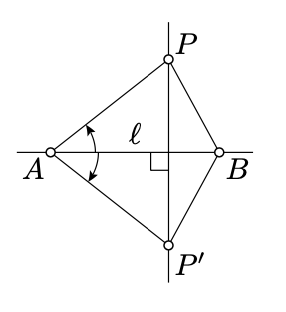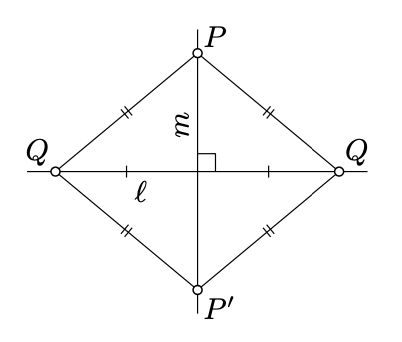5.3: Unicidad de una perpendicular
- Page ID
- 114818
Hay una y sólo una línea que pasa a través de un punto dado\(P\) y es perpendicular a una línea dada\(\ell\).
Según el teorema anterior, hay un punto único\(Q \in \ell\) tal que\((QP) \perp \ell\). A este punto\(Q\) se le llama el punto del pie de\(P\) on\(\ell\).
- Prueba
-
Si\(P \in \ell\), entonces tanto la existencia como la singularidad siguen de Axioma III.

Existencia para\(P \not\in \ell\). Dejar\(A\) y\(B\) ser dos puntos distintos de\(\ell\). Elige\(P'\) para que\(AP' = AP\) y\(\meauredangle BAP' \equiv - \measuredangle BAP\). Según Axioma IV,\(\triangle AP'B \cong \triangle APB\). En particular,\(AP = AP'\) y\(BP = BP'\).
Según el Teorema 5.2.1,\(A\) y se\(B\) encuentran sobre la bisectriz perpendicular a\([PP']\). En particular,\((PP') \perp (AB) = \ell\).
Singularidad para\(P \not\in \ell\). Desde arriba podemos elegir un punto de tal\(P'\) manera que\(\ell\) forme la bisectriz perpendicular a\([PP']\).

Asumir\(m \perp \ell\) y\(P \in m\). Entonces\(m\) es una bisectriz perpendicular a algún segmento\([QQ']\) de\(\ell\); en particular,\(PQ = PQ'\).
Ya que\(\ell\) es la bisectriz perpendicular a\([PP']\), obtenemos eso\(PQ = P'Q\) y\(PQ' = P'Q'\). Por lo tanto,
\(P'Q = PQ = PQ' = P'Q'\).
Por Teorema 5.2.1,\(P'\) se encuentra sobre la bisectriz perpendicular a\([QQ']\), que es\(m\). Por Axioma II,\(m = (PP')\).


